Updated 5/20/16
1) Levenhuk 80mm Ra ED Triplet OTA 3/20/16
2) Astro-Tech AT66 OTA 5/20/16
(80 mm f/6 triplet apochromatic refractor OTA , hard case, $779 street)
Not long ago, I lamented the lack of "middle-class" scopes - stuff that an enthusiast could appreciate, but still within reach of a working stiff. I shouldn't have worried. We are living in a golden age of equipment. There are so many nice telescopes out there at attractive prices that I'm having trouble keeping track of them all. Enter this fine refractor from Levenhuk. The triplet promises better color correction than your run of the mill Orion ED80-class scope, at a modest increase in price. Now anyone can be a big shot, for less than $1000.
The Levenhuk 80 packs a lot of performance in a tiny package. When I borrowed the scope from club member Mike T, my first reaction upon seeing the case was, That's it? That's the whole thing? It's so cute! I'd expected something about the size of an Orion ED80. What I got was something more along the lines of an Orion Short Tube 80. Yes, it's that small. The case measures a mere 17.5" X 9.75" X 7.25." You'll have no trouble carrying it on plane*. The case isn't much larger than the one for my AT72 (previous page.) It turns out the AT72 is a good jumping off point for a review of the Levenhuk. If you read my comments on the AT72, the Levenhuk 80 is just a little bit more - a little more aperture, a little better color correction, better appointments (finder bracket shoe, larger and heavier focuser, longer dew shield that doesn't slip back when you extend it.) Of course, you do pay more.
* Note: The TSA seems to be getting more sensitive these days. A reader from South Carolina offered this piece of advice. If you fly with your scope, put a note inside the case stating "Astronomical Telescope" in big letters. To reinforce the point, print out an ad from a web site and stuff it in there too. The reader also suggests not locking your case. If the TSA people don't have a generic key for your case (and this Levenhuk case does lock) they may become even more zealous to open it .
Levenhuk 80 and its case
Close up of focuser
The metal OTA has a 102 mm diameter and weighs about 5.7 lbs. Like the AT72, there's a metal Vixen-compatible shoe at the bottom. As with the AT72, the Levenhuk is really nicely finished, so do the right thing. Mount another plate underneath the shoe and mar that up instead of the scope itself. I've expressed mixed feelings about these Crayford-style focusers in the past, but the one on this Levenhuk is pretty good. It had no trouble holding and focusing my 2" AP diagonal and 26 mm Nagler, nor did it have a problem with my EOS 5D camera. I appreciated the finder shoe. Some people feel that a rich field scope functions as its own finder, but I always like the option of using a separate finder. The scope is light enough to use on an alt-az mount like a Vixen Porta, but if an equatorial mount is your thing, a CG-4 class mount is more than enough. If you have a CG-5 or an AVX, you're going to be in really good shape. In addition to the mount, you'll need to supply your own diagonal, finder, and eyepieces.
A simple, light setup - Vixen Porta mount, TeleVue 1.25" diagonal, 19 mm Panoptic
Something a little more complex. Set up for imaging with AVX mount and SBIG STi autoguider
I used the scope over a few weeks during the warm 2015/2016 winter. At 100X, the star test showed minor undercorrection. It's not a big deal. The patterns look slightly better than the 1/4 diagrams in Suiter's book. I've become wary of reporting these star test results because people can make too much out of them, but refractor enthusiasts (you know who you are) tend to be a passionate lot. There's little to no false color than I can detect, either visually, or in the images I took (there are some minor blue halos in the Horsehead image near the end of this review; you be the judge.) The winter showpiece objects looked just fine. I enjoyed the views of M42, M45, the Double Cluster, and the Messier clusters in and around Auriga. Staying up a little later one night, I looked at M81 and M82, which are no problem. M65.M66, and NGC3628 are a little dimmer, but still within reach. I was just able to split Izar (Epsilon Bootes) and the scope's owner has split Delta Cygnus with it (the latter is normally a test for a 4" telescope.) In addition to the two large bands on Jupiter, you can just start to see some of the dimmer thin bands near the poles, and on one night I caught a nice shadow transit. Note that if you're going to be splitting close doubles or observing planets, a tracking mount is a must, as is a barlow. With only 480 mm of focal length to work with, you need optical help to get the power up.
Top to bottom: Astro-Tech AT72, Levenhuk 80, Takahashi FC-76
Limitations? An 80 mm scope is still only 80 mm, and if you're a deep sky fan, you're going to run out of aperture after a while. While I did see the Leo Triplet (M65/M66/NGC3628) I'm not sure how much deeper I could have gone. My Takahashi is sharper, and has a near-perfect star test (it had better, given what it costs.) It's fair to point out that for imaging, the Levenhuk will almost fully illuminate a full-frame sensor like the one in my EOS 5D, while the FC-76 (in its current configuration at least) struggles to do so. The Tak is also (see above) incredibly, almost twice the size. The Levenhuk is a great second portable scope, used in combination with something like an 8" reflector. I've also heard from some of you who go in the "opposite" direction, starting with a small refractor and then branching out to a larger aperture reflector or SCT. Either way, you're going to wind up with a really nice scope. If you liked what you've read so far, but can't swing the $779, you can always downshift to the Orion ED80 (Vixen sells a similar looking model.) It isn't as well made, is only a doublet, and is limited 1.25" but used ED80s are cheap (I've seen clean used samples being sold for next to nothing.)
You'd expect a wide field apo to be a good partner for imaging, and you'd be right. I wound up spending a lot of time taking images through it. Maybe too much! But as any imager will tell you, once you get rolling, it's hard to stop. You start wondering what else it can do. I'm amazed at what amateur imagers can do these days. I grew up during a time when the Horsehead was a kind of Holy Grail for photographers. These days, an autoguider and a few three minute subs at ISO 1600 will do the trick. Note that for best results, I did have to use a field flattener. My inexpensive Astro-Tech unit worked just fine.
Positive reviews are sometimes the hardest ones to write. I couldn't find anything wrong with it. If I didn't already own the AT72 and a Takahashi FC-76, I'd probably buy one. Highly recommended.
-Ed
Gallery (below): Astro-Tech field flattener, Celestron AVX mount, SBIG STi autoguider, PHD guiding, Deep Sky Stacker, CS3. ISO 400 on the Orion Nebula, ISO 800 or 1600 on the rest. HuTech modded Canon EOS 5D Mk 3. 45 second subs on Orion Nebula, 3 minute subs on the rest. Images reduced for web site. Email me if you want the full sized jpegs.
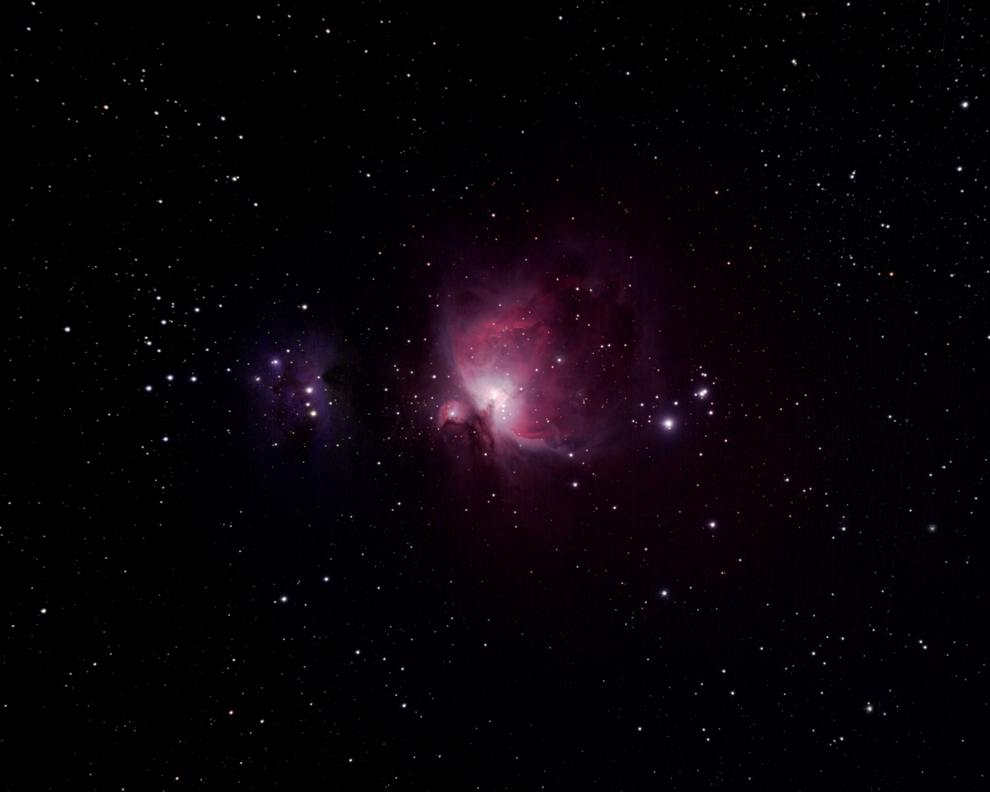
M42, the Orion Nebula
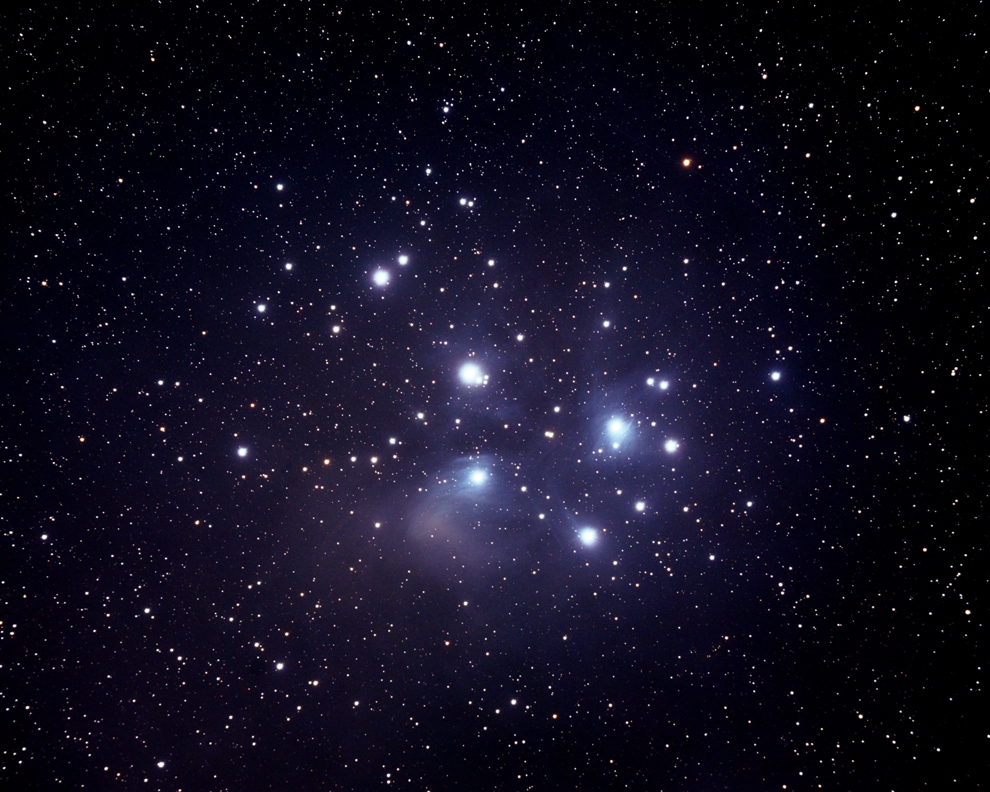
M45, the Pleiades
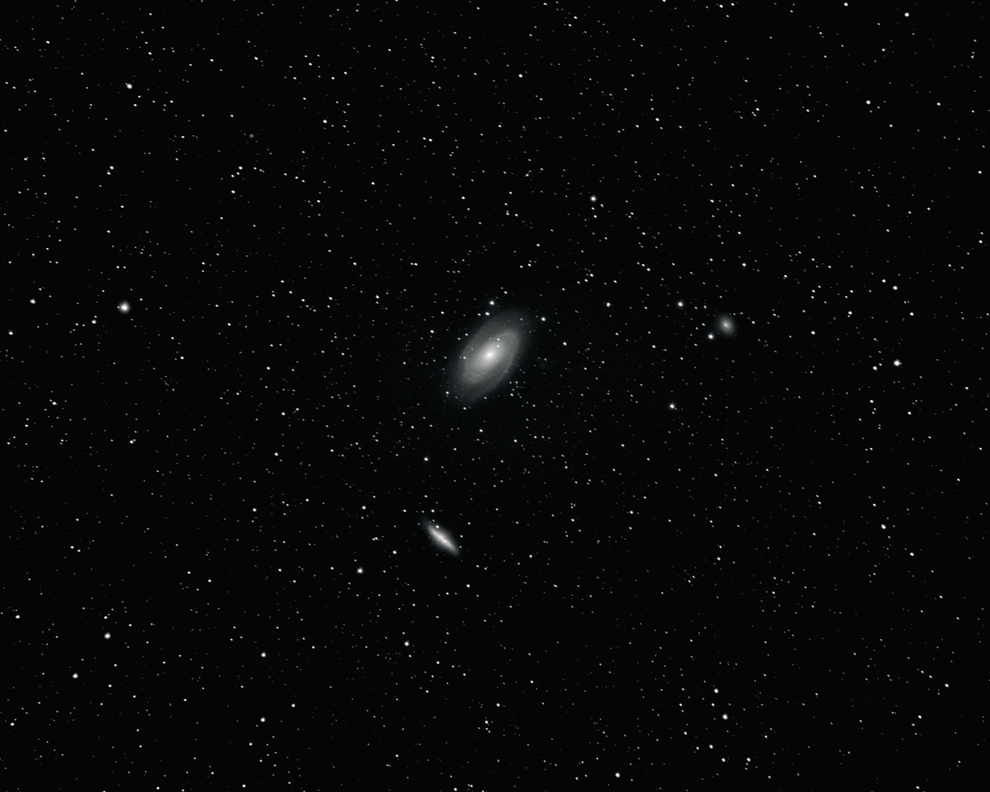
M81/M82
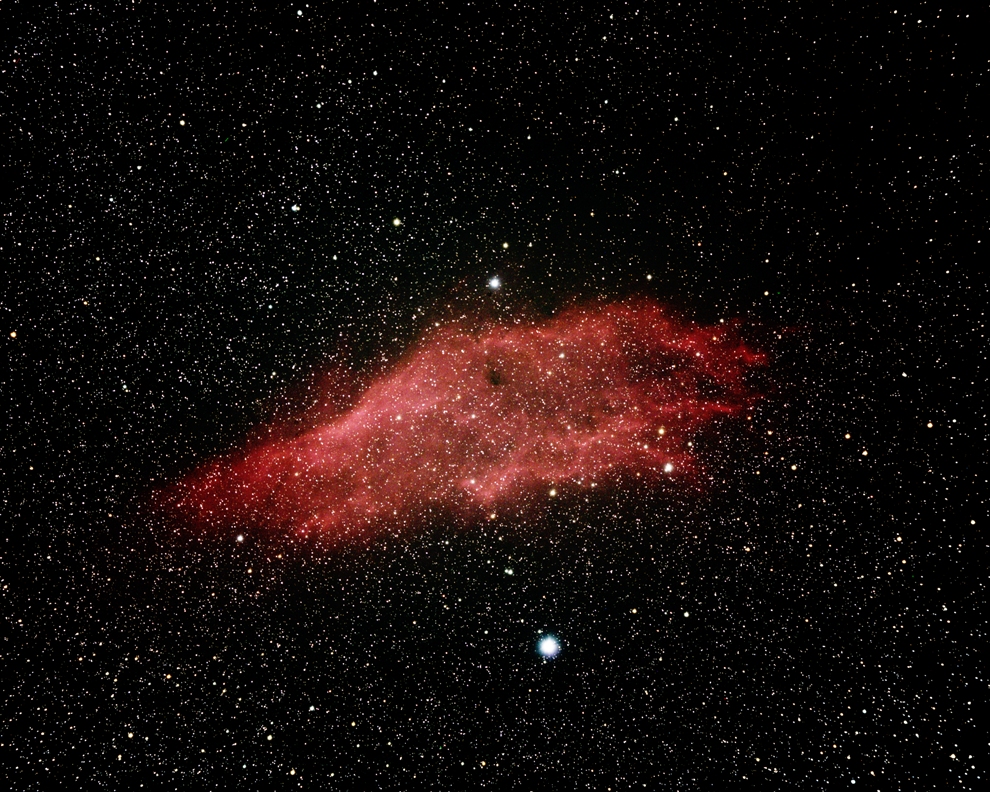
NGC1499, the California Nebula
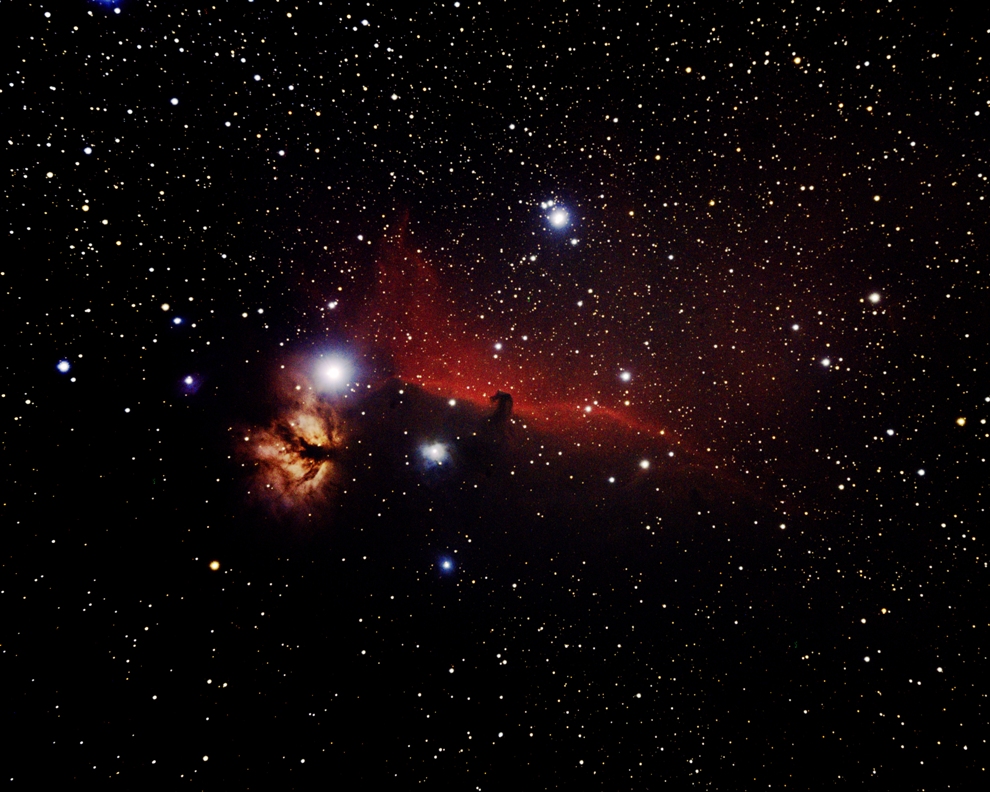
The Horsehead Nebula
(66 mm f/6 apochromatic refractor OTA, case, about $250 used, NLA)
'Tis the season for small refractors, at least at my place. I picked this up off Astromart as an impulse buy. I was curious to see how it compared to the AT72, a scope that I'm liking more and more as time goes on. The shorter focal length would give about 20% more field of view, as I intended to use it for both visual and photographic applications. Astro-Tech doesn't sell these anymore; they've been supplanted by the AT72 and the AT65, but you see these on the used market all the time, often at very attractive prices. William Optics sold a model around the same time as these with identical-looking specs. Give Astro-Tech some credit for some whimsy. The AT66s were available in lots of interesting colors, aside from the usual white and black. I've seen them in gold, red, blue, "Cylon-Toaster" chrome, gold, and even pink. Just be aware if you get one of the funky colors, the anodization sometimes wears off. My blue sample is already starting to show some of that unintended "two tone" look.
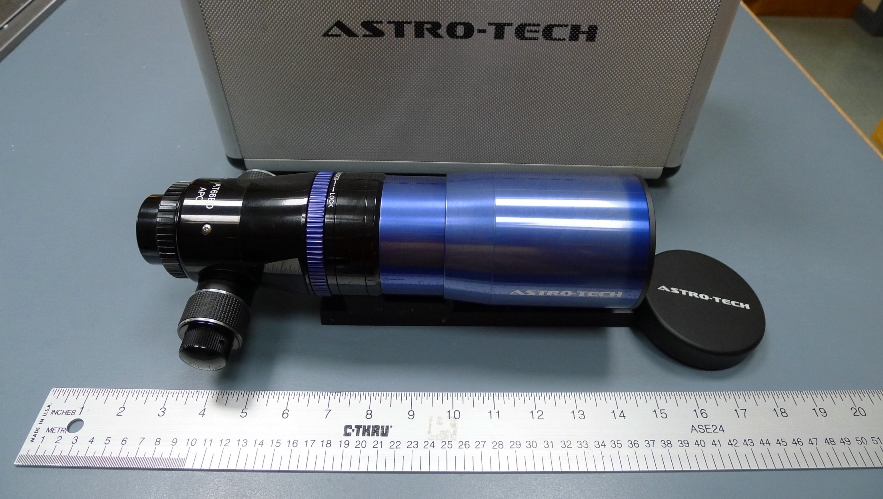
Astro-Tech AT66, in blue. Note the anodization is starting to wear off
If you're thinking you'll get one of these to save some size and weight compared to an AT72, think again. The scope ships in the same case as the AT72 (when it came in the mail, I thought the owner had accidentally shipped me an AT72 by mistake) and it isn't much smaller or lighter. Look at the pictures and judge for yourself. It appears to use the same focuser as the AT72, and depending on how you store it, the AT66 is actually a tad longer than the AT72.
I'll get the weird stuff out of the way first. The rotating focuser uses a knurled locking ring, as opposed to the simple set screw on the AT72. While there's nothing wrong with this arrangement, I never got entirely comfortable with it and wished for the set screw. But more weirdness abounds.
The AT66 comes with a 1.25" SCT visual back.
Say what??
Now, there's no reason why you can't put an SCT visual back on a refractor, but this is the first time I've run across it, aside from the William Optics 66 clone unit. My guess is that they're trying to discourage you from putting big fat 2" accessories on the back, knowing the scope won't fully illuminate the field of view. If true, this alone give the AT66 a big disadvantage compared to the AT72, which has no trouble taking 2" diagonals and eyepieces. Being owned by several SCTs at the moment, I did the natural thing. I grabbed my TeleVue and AP 2" SCT visual backs and threaded them on to the AT66. Hey, no one's going to tell me what accessories I can put on my scope!
But doing so, I immediately ran into a problem, as the TeleVue visual back kept on threading, and threading, and...screwed itself all the way through. You see, on a normal SCT, there is a mechanical stop that prevents you from threading the visual back on any further. Usually, this "stop" is the back of the SCT itself. There is no such stop on the refractor drawtube of the AT66, so you can just keep threading until the thing goes all the way through to the other side. This stumped me for an afternoon, until I came up with a low-tech solution: masking tape. You just need to keep the visual back from spinning. Satisfied, I inserted a 2" AP diagonal into the TeleVue 2" visual back.
The AT66 does not have enough in-focus travel to accommodate a 2" diagonal and visual back.
OK, OK, I get it. They really don't want you using 2" eyepieces with this scope. Which, of course, only made me want to do it even more. I took out the diagonal, put in a big 27 mm Panoptic, and looked through the scope in daylight at a tree with no expectations...and...hey, it's not too bad. There's a little light falloff near the edges, but it's not nearly as bad as I expected. Thus encouraged, I left my masking tape kluge in place and stuck my full-frame EOS 5D Mk 3 in the scope and did some imaging.
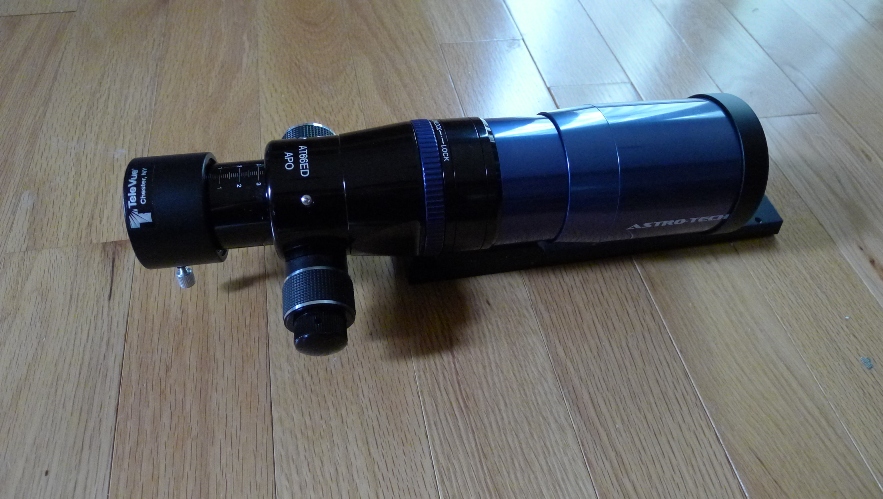
AT66 with 2" SCT visual back attached. I'll spare you the photo of what it looks like with all the masking tape wrapped around it.
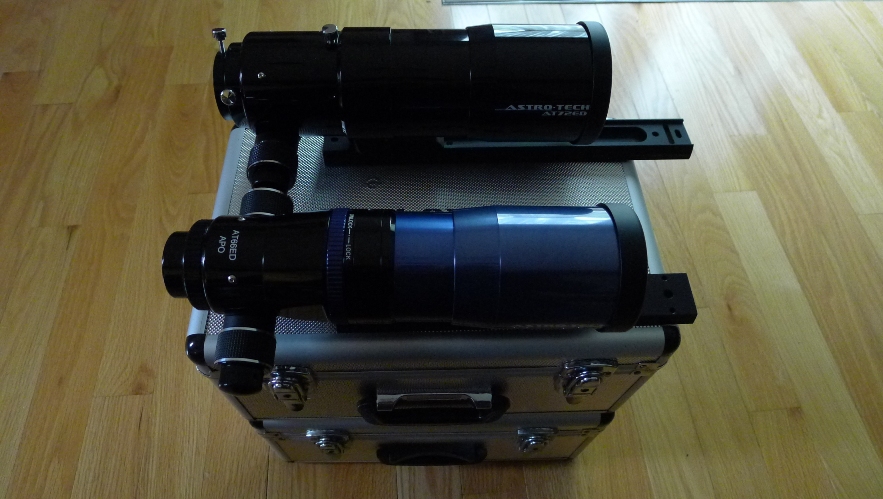
AT72 (top) and AT66 (bottom)
Again, I was surprised how little light falloff I experienced, even with a full-frame sensor, a demanding application for refractors much more expensive than this one.
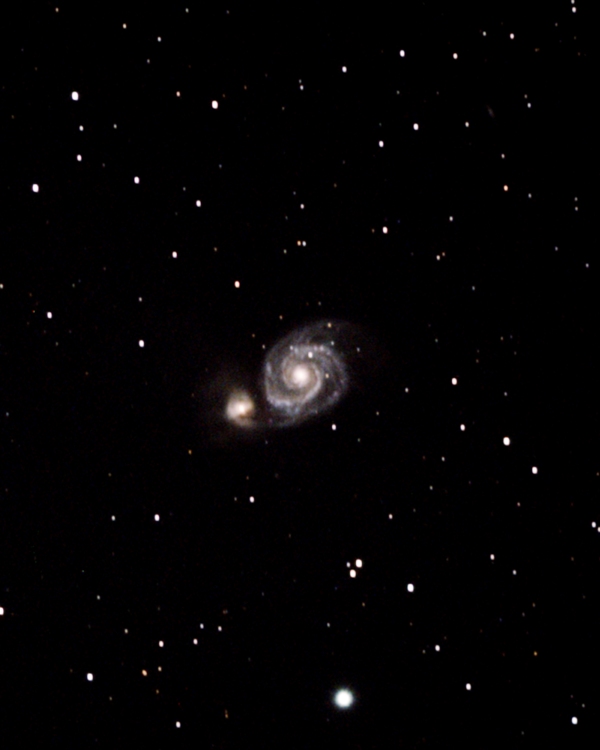
M51
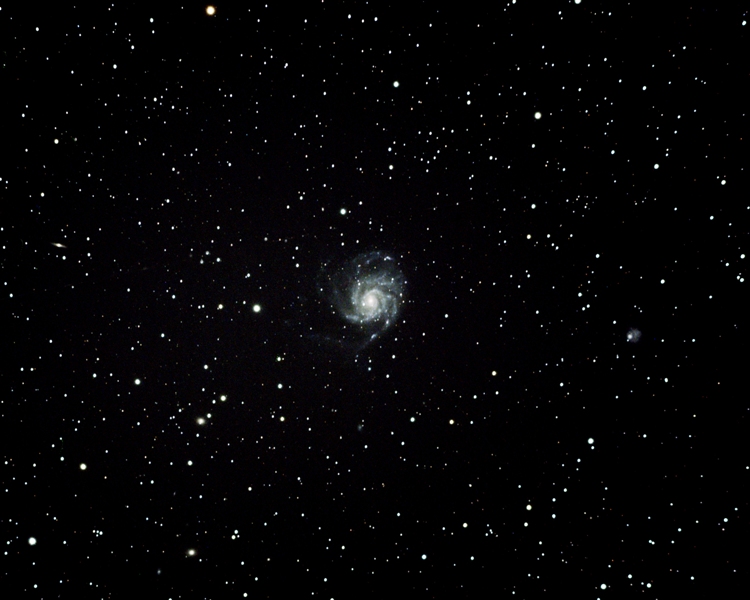
M101
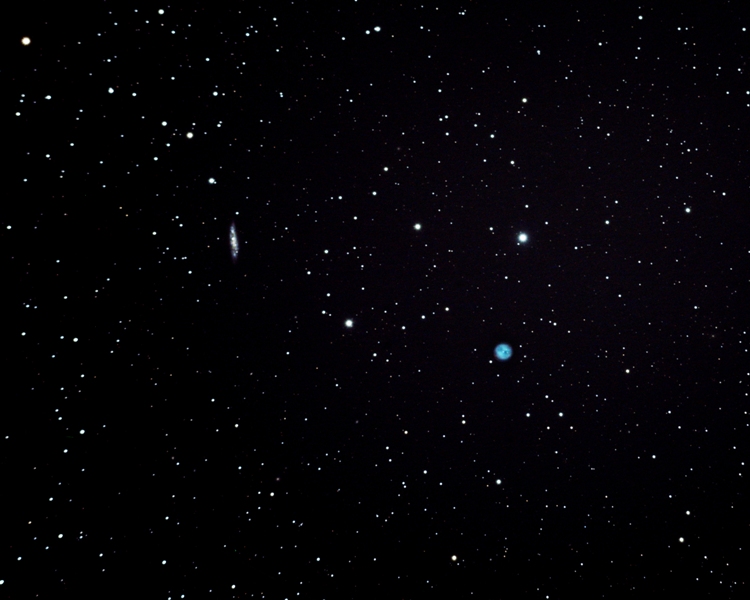
M108 and M97
(All: AT66 with TeleVue 2" SCT visual back, Astro-Tech Field Flattener, AVX mount, SBIG STic autoguider, HuTech modded Canon EOS 5D Mk3, 3 minute subs at ISO 1600, total exposure time varies from 30 to 60 minutes, PHD Guiding, DSS, CS3.)
All right, already - doesn't anyone ever look through their telescopes anymore?! I find myself saying this to my local club members, even as I succumb to the astrophotography bug myself. Yes, folks - you can look through these things! I used the scope on my Vixen Porta. The AT66 showed some minor undercorrection, and just a tiny trace of false color. The latter was only apparent at higher power, and only on bright objects. Both aberrations are a bit more than the ones in the Levenhuk 80, above, and neither detracted from the quality of the views. Jupiter showed two cloud bands, a bit of salmon color, and the four moons are easy. Cassini's Division on Saturn is easy. Mars, however, never showed itself to be anything more than a featureless reddish blob.
On deep sky, you start running out of objects to see. M13 and M3 showed some light granulation, but individual stars were hard to pick out. At low power, M92 looked more like a bright galaxy than a globular. The AT72 is a little better in this regard, but you really do need to move up to the four-inch class before globulars start getting resolved; a six or eight inch Newtonian is even more satisfying. M81 and M82 showed their individual personalities. I did catch the M65/M66/NGC3628 trio in Leo, but I didn't have any fun looking at them. From my magnitude 4 skies, I had a lot of trouble picking out the galaxies in the Virgo Cluster. I have no doubt that under better conditions, I could have caught some of the brighter members like M84 and M86, but as with the Leo Triplet, I doubt they would be any fun to look at.
The lack of deep sky performance isn't the fault of the scope. 66 mm is still 66 mm, and as a great philosopher once said, you 'canna change the laws of physics, Captain. Recommended as a guide scope, as a backup scope, for filling out larger collections, or for the curious.